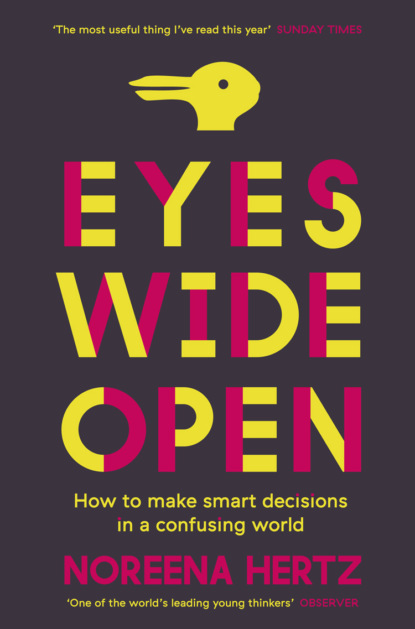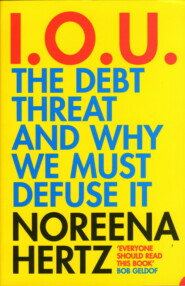По всем вопросам обращайтесь на: info@litportal.ru
(©) 2003-2024.
✖
Eyes Wide Open: How to Make Smart Decisions in a Confusing World
Автор
Год написания книги
2019
Настройки чтения
Размер шрифта
Высота строк
Поля
• Start considering how you have typically viewed experts and conventional big-hitters until now. Do you tend to accept their views and ideas without question?
• Ask yourself more generally who it is you trust and why.
• Contemplate your current strategies for dealing with the digital deluge. Think about the short cuts you take, and how you determine which information to base your decisions on. Begin thinking about how these may be impacting on the quality of your thinking.
KEEP YOUR EYES WIDE OPEN (#ufc35ab50-20fa-5b82-b206-9fdae6e0d1ec)
STEP TWO (#ufc35ab50-20fa-5b82-b206-9fdae6e0d1ec)
See the Tiger and the Snake
The Tiger and the Snake
In 2005, the prominent American cognitive psychologist Professor Richard Nisbett began an extraordinary experiment.
After some careful planning, he showed a group of American students and a group of Chinese students a set of images for just three seconds each. The images were pretty varied: a plane in the sky, a tiger in a forest, a car on the road – you get the idea.
How would the American and Chinese students view these images, the Professor wondered. Would they see them differently? Would they see the same things? If there was a snake on the ground, say, would the Americans or the Chinese notice it?1 (#litres_trial_promo)
The Professor’s methods were clinical. Upon entering the room, the students were placed in a chair, with their chins in a chin rest at a distance of precisely 52.8cm from the screen. They were then strapped in to 120Hz head-mounted eye-movement trackers. Nisbett could track every squint, glance or flicker of attention.
The differences between the two sets of students were immediately apparent.
The Americans focused on the focal object: the plane, the tiger, the car. They pretty much fixated on these, and barely looked at the background.
The Chinese, on the other hand, took longer to focus on the focal object – 118 milliseconds longer. And once they had done that, their eyes continued to dart around the image. They took in the sand, the sunlight, the mountains, the clouds, the leaves.
So if there was a snake on the ground behind the tiger, it would be the Chinese, not the Americans, who would see it.
All That Glitters …
In a complex world of hidden dangers and fleeting opportunities we all need to be able to see snakes as well as tigers.
We have to understand that the picture we see at first may not give us all the information we need to make the best possible decision. We need to learn to see beyond what is obvious, beyond what we are culturally or conventionally attuned to focus on.
Of course, this doesn’t mean that we shouldn’t ever act until we’ve gathered every single piece of information out there that may be relevant to our decision. That would be excessively time-consuming, and our brains wouldn’t be able to cope with all that data anyway.2 (#litres_trial_promo)
But what the tiger-and-the-snake experiment tells us is that the information we’re most prone to focus on may only give us a very partial story, a fragment of the truth, and therefore risks misleading us. Being aware of this, and adjusting accordingly, will make a profound difference to the decisions you make.
Take internet dating. Studies show that men are most attracted to photos of women with large eyes, a big smile and high cheekbones.3 (#litres_trial_promo) Glossy hair, full lips and smooth skin are also a big draw.4 (#litres_trial_promo) It’s also the case that women who describe themselves as ‘voluptuous’ or ‘portly’, or ‘large but shapely’, are contacted far less online than women who are slightly underweight.5 (#litres_trial_promo)
That’s how it goes with a lot of male browsers. What about women? Well, women seem to focus more on height. Men listed as between six foot three and six foot four receive about 60 per cent more first-contact emails than men in the five foot seven to five foot eight category.
But are superficial features such as the fullness of a woman’s lips or a man’s height really the best things to focus on if you’re looking to choose the right partner?
The answer, unsurprisingly, is a categorical ‘no’. Studies of successful long-term relationships point to less superficial qualities such as sense of humour, shared interests and common values as being much better indicators of whether a couple are well matched.6 (#litres_trial_promo) Deep down, most of us know this, yet the majority of online daters only focus on one part of the picture.
Politicians, economists and investors can easily fall in to the same trap.
They tend to focus overwhelmingly on economic growth as the ultimate indicator of how well a country is doing. Yet growth indicators tell us nothing about how that growth was achieved.
If you cut all your trees down to sell the wood for kindling, that would be good for growth; but would it really be a measure of how successful you were as a nation? Clearly not. Think of all the problems that the destruction of the rainforests has caused to local habitats as well as its contribution to global warming. Then add to that the very significant associated future economic costs of this kind of short-term thinking.
‘Growth’ also does not tell us anything about how spoils are shared, about inequality levels, or gender differences, or the rumblings of discontent that can mutate into revolution. It yields, in reality, relatively little information on how a country is actually faring, or will fare in the future. In Russia, the economy has been growing at the same time as life expectancy has been falling.7 (#litres_trial_promo) In the United States, during the noughties there was growth, but at the same time median family income declined, and there was no net job creation.8 (#litres_trial_promo) So if you are a prime minister or an investor, or just a concerned citizen, the modern economic obsession with digits of growth can end up being the tiger that means you don’t see the snake creeping up on you on the forest floor.
Think also of the doctor who no longer carries out a physical examination or takes a detailed case history, but instead focuses overwhelmingly on blood tests or scan results – you’ve probably come across the type.
While blood tests and scans can of course yield important, often life-saving information, in many cases these static findings cannot on their own determine what is wrong with you. The best doctors are still those who listen to you, touch you and try to establish the individual characteristics of your situation. Such doctors use the static readings of your test results as potential clues to what’s wrong, but not as the sole way of defining and diagnosing you.9 (#litres_trial_promo) As Dr Athina Tatisoni, of the prestigious Tufts University School of Medicine, remarks:
Usually what happens is that the doctor will ask for a suite of biochemical tests – liver fat, pancreas function, and so on … The tests could turn up something, but they’re probably irrelevant. Just having a good talk with the patient and getting a close history is much more likely to tell me what’s wrong.10 (#litres_trial_promo)
Doctors, like investors, like dating-site users, like all of us, need to get better at thinking about the whole picture. We need to look beyond what is immediately obvious or easy to see. For if we are to see a snake as well as a tiger, if we are to see what it is we need to see, we must remember that the information that glitters most brightly may not actually be what will serve us best.
The Unicycling Clown
Sometimes we are so focused on one thing in particular that we actually stop seeing the other things we need to take into account.
Just ask Dustin Randall.
One might think that, dressed in a vivid purple-and-yellow outfit, with large shoes and a bright-red nose, Dustin the clown would be pretty impossible to miss.
Especially when he was riding a unicycle around a small university campus square.
But researchers at the University of Washington discovered otherwise. When Dustin rode by people who were crossing the square while using their mobile phones, the vast majority completely failed to notice him.11 (#litres_trial_promo) It was as if the unicycling clown simply wasn’t there.
This is an example of a phenomenon known as ‘inattentional blindness’,12 (#litres_trial_promo) and it’s what happens when we’re very focused on one thing in particular – in this case a telephone conversation or an important text message. When we are focused like this, we typically don’t register new data points, new things that may come in to our sensory orbit. We can even miss highly visible objects we are looking directly at, because our attention is elsewhere.13 (#litres_trial_promo) One professor rather brilliantly describes it as being ‘as if while the eyes “see” the object, the brain does not’.14 (#litres_trial_promo)
This is something we are all likely to have experienced. Have you ever bumped into a lamp-post while walking and texting? Or somehow missed seeing an important email in your inbox during a particularly busy week? If so, you can blame inattentional blindness.
There are times, of course, when tunnel vision clearly pays off – think of your hunter-gatherer ancestors, seeking out food and doing everything they could to avoid mortal danger. Once they heard the lion’s roar, there would only be two things to think about: working out where that roar was coming from, and running in the other direction. They would not have wanted to be distracted by anything else – the pain in their muscles as they ran, the sound of birds singing above, the sight of their favourite snack hanging from a tree – these would all have been irrelevant to their immediate survival.
But fast-forward a few millennia, and if you don’t want to get knocked over by a unicycling clown, miss a critical email or fail to spot a wrong charge on your credit-card statement, you’ll need to take your blinkers off and with eyes wide open improve your powers of attention and perception.
Think about what it is that is consuming your focus. At work, this may be your latest sales figures, or your company’s current stock price. At home, it may be the football scores. How many times a day do you check these? What might this mean you’re not paying attention to? Could you spend a day (or even a few hours) without looking at them? What would you notice that you hadn’t previously? And who around you could bring the unexpected to your attention? More on this point to come.
From PowerPoint to Hypnotised Chickens
Sometimes it is not our fault that we’ve only got partial vision.
Edward Tufte (pronounced tuff-TEE), an American statistician and Professor Emeritus of Political Science, Statistics and Computer Science at Yale University, knows this all too well.
A man of many talents, Tufte was hired by President Obama in 2010 to keep an eye on how his $787 billion stimulus package was being spent.15 (#litres_trial_promo) He also has a sideline gig as an exhibiting sculptor. But in his academic career he has undertaken substantial research into how informational graphics impact on decision-making.16 (#litres_trial_promo)
One case he has looked at in real depth is the Columbia Space Shuttle disaster of February 2003. Seven astronauts lost their lives when their NASA spacecraft disintegrated shortly before the conclusion of a successful sixteen-day mission.
It is now well-known that a briefcase-sized piece of insulation foam from the Shuttle’s external fuel tank collided with its left wing during take-off, meaning that the Shuttle was unable to shield itself from the intense heat experienced during re-entry to the earth’s atmosphere.
But the official investigation also revealed a story that is both fascinating and curiously everyday in its nature.






